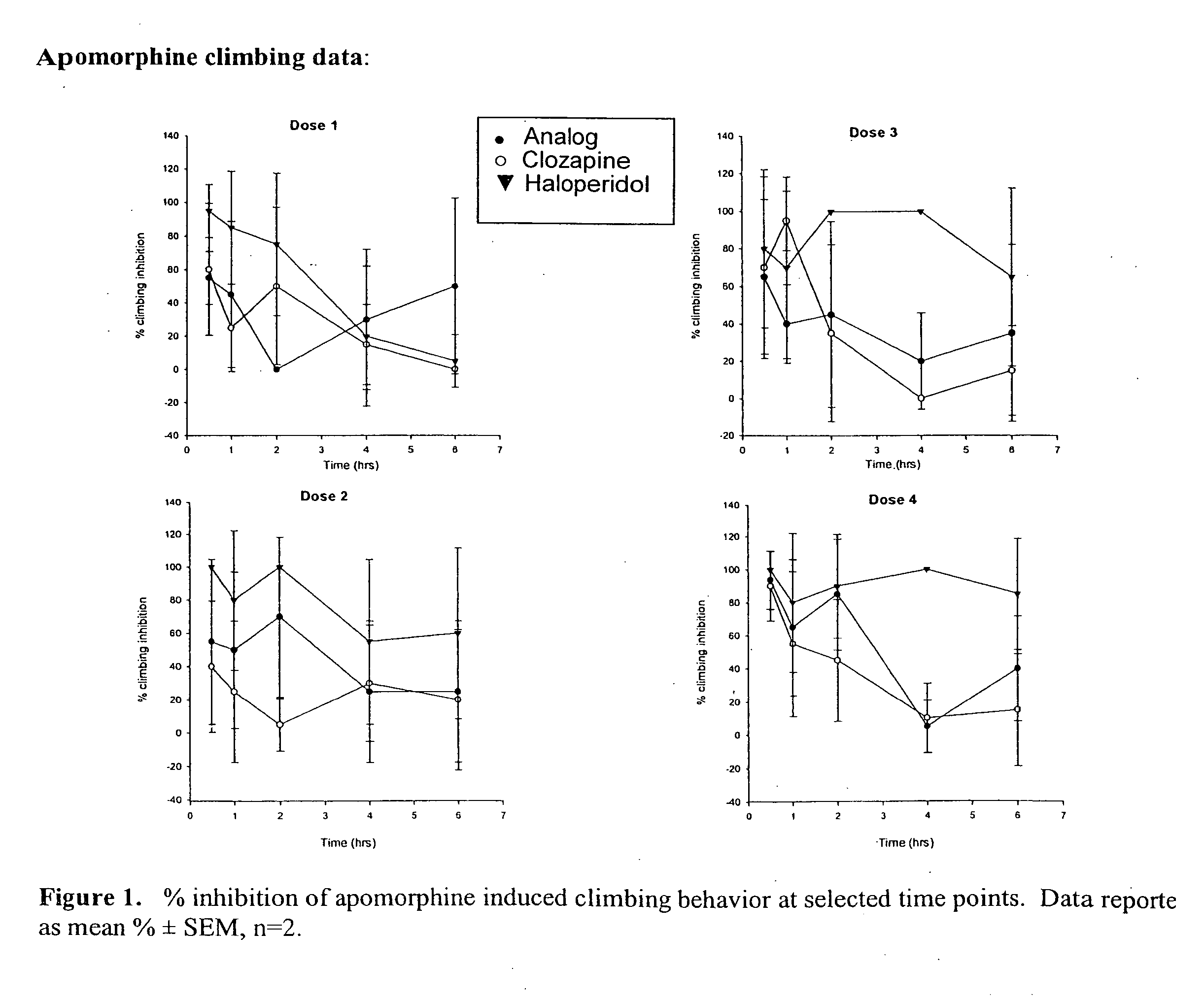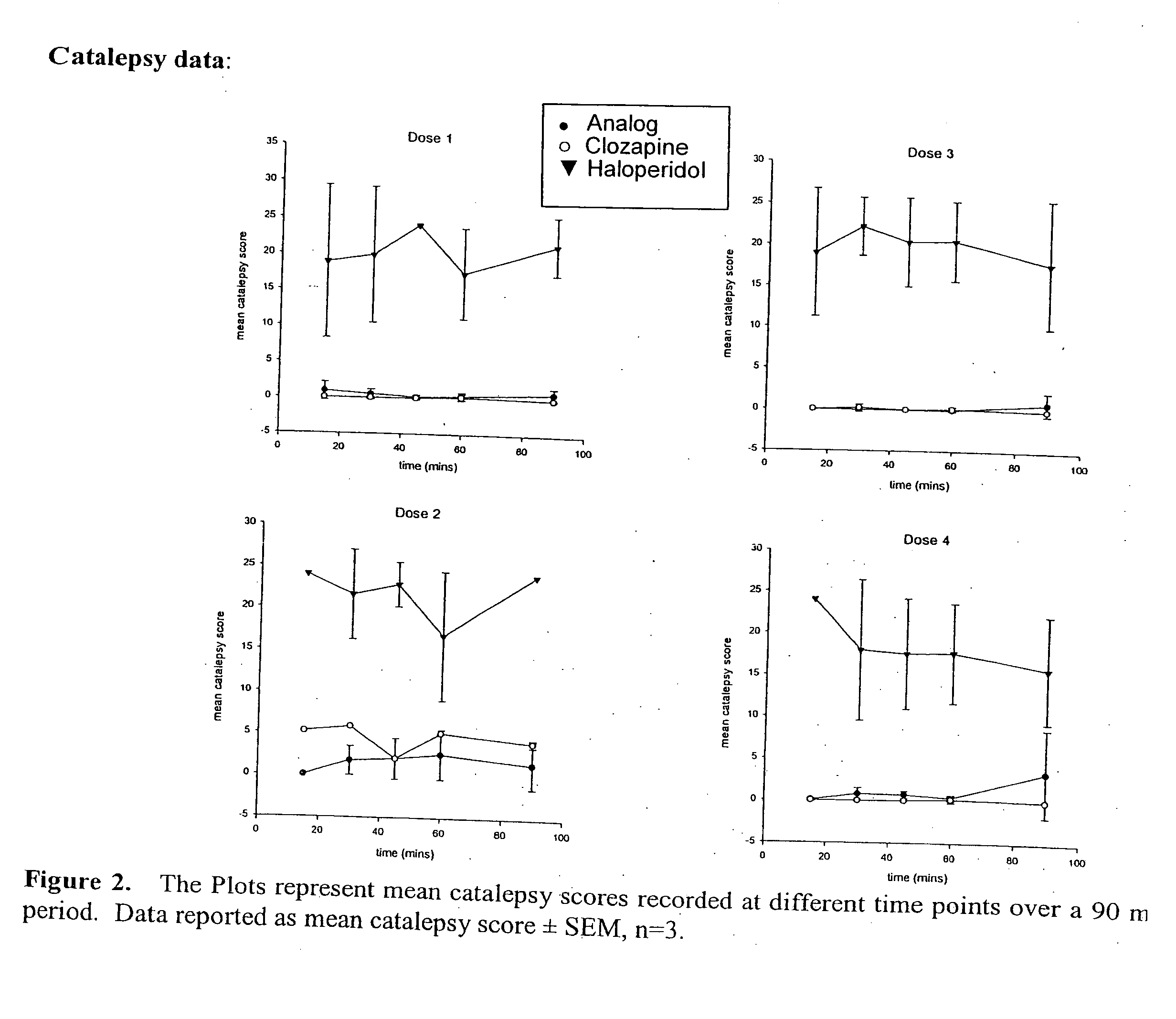Haloperidol analogs
analogue technology of haloperidol and haloperidol, applied in the field of analogs of haloperidol, can solve the problems of psychotic patients who will almost certainly relapse, known neuroleptics producing unwanted side effects, and their own side effects such as mental and/or physical impairment, and achieve the effect of meliorating the associated symptoms
- Summary
- Abstract
- Description
- Claims
- Application Information
AI Technical Summary
Benefits of technology
Problems solved by technology
Method used
Image
Examples
example 1
[0052] 4-[3-hydroxy-3-(4′-chlorophenyl)pyrrolidinyl]-4″-fluorobutyrophenone [A1] 1-Carbethoxy-3-hydroxy-3-(4′-chlorophenyl)pyrrolidine (1). Grignard reagent for this reaction was obtained from Mg (3.1 g, 0.129 g-atom), 1-bromo-4-chlorobenzene (23.0 g, 0.12 mol.) and anhydrous Et20 (200 mL) and the resulting mixture was refluxed for 5 h. A solution of ketone
(13.3 g, 0.085 mol.) in dry THF (100 mL) was added rapidly and the resulting mixture was allowed to reflux with stirring for 24 h. The mixture was allowed to cool and 30% NH4Cl solution was added until all solids dissolved. The aqueous phase was separated and extracted with Et2O (3×100 mL). The combined organic phase was shaken with H2O (50 mL) and dried (Na2SO4). The solvent was removed under reduced pressure to afford an oil (13.7 g, 60%). Column chromatography on silica gel afforded the desired product; mp 83-86° C. IR (Neat, cm−1) 3400 (br., OH), 1680 (NCOOEt). 1H-NMR (CDCl3) δ 1.20-1.27 (t, 3H, CH3), 2.13-2.27 (m, 2H, C4-H...
example 2
[0055] The method of Bercz [Bercz, C. V.; Ice, R. D. Synthesis of 1-carbethoxy-4-cyano-4-phenylpiperidine, J. Pharm. Sci. 1972. 61, 1316-1317] was employed to obtain the starting material
for the synthesis of 5 {4-(4′-Chlorophenyl)-4-methylenehydroxy-1-[4-(4-fluorophenyl)4-oxobutyl]piperidine}. Hydrolysis of 21 to form acid 22 [4-(4′-Chlorophenyl)-4-carboxy-1-phenylpiperidine], followed by esterification and reduction of the ester yielded intermediate 23
Debenzylation of 23 and sub-sequent alkylation produced compound 5.
[0056] 4-(4′-Chlorophenyl)-4-carboxy-1-phenylpiperidine (22). A mixture of H2O (1 mL) and sulfuric acid (2 mL) was added to compound 21 (2 g), and the resulting mixture was refluxed overnight. Solvent was removed under vacuum to produce a residue. The residue was dissolved in MeOH (20 mL), and concentrated sulfuric acid (3 mL) was added. The resulting mixture was stirred under reflux overnight, cooled to room temperature, neutralized with Na2CO3, and extracted wi...
PUM
 Login to View More
Login to View More Abstract
Description
Claims
Application Information
 Login to View More
Login to View More - R&D
- Intellectual Property
- Life Sciences
- Materials
- Tech Scout
- Unparalleled Data Quality
- Higher Quality Content
- 60% Fewer Hallucinations
Browse by: Latest US Patents, China's latest patents, Technical Efficacy Thesaurus, Application Domain, Technology Topic, Popular Technical Reports.
© 2025 PatSnap. All rights reserved.Legal|Privacy policy|Modern Slavery Act Transparency Statement|Sitemap|About US| Contact US: help@patsnap.com



